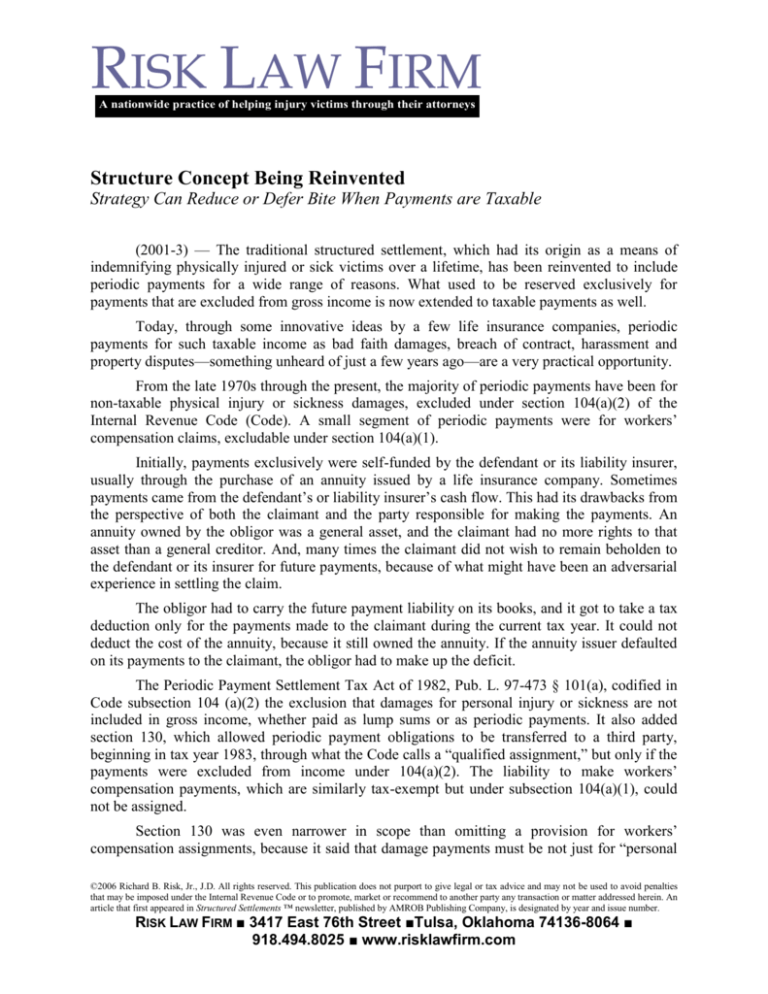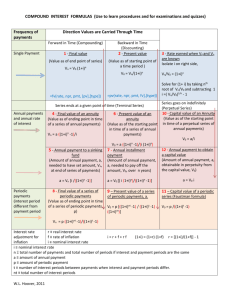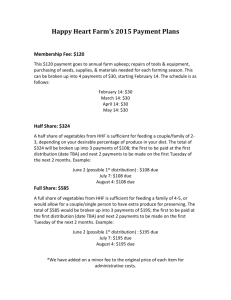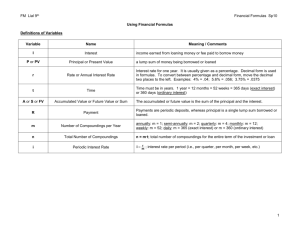
RISK LAW FIRM
A nationwide practice of helping injury victims through their attorneys
Structure Concept Being Reinvented
Strategy Can Reduce or Defer Bite When Payments are Taxable
(2001-3) — The traditional structured settlement, which had its origin as a means of
indemnifying physically injured or sick victims over a lifetime, has been reinvented to include
periodic payments for a wide range of reasons. What used to be reserved exclusively for
payments that are excluded from gross income is now extended to taxable payments as well.
Today, through some innovative ideas by a few life insurance companies, periodic
payments for such taxable income as bad faith damages, breach of contract, harassment and
property disputes—something unheard of just a few years ago—are a very practical opportunity.
From the late 1970s through the present, the majority of periodic payments have been for
non-taxable physical injury or sickness damages, excluded under section 104(a)(2) of the
Internal Revenue Code (Code). A small segment of periodic payments were for workers’
compensation claims, excludable under section 104(a)(1).
Initially, payments exclusively were self-funded by the defendant or its liability insurer,
usually through the purchase of an annuity issued by a life insurance company. Sometimes
payments came from the defendant’s or liability insurer’s cash flow. This had its drawbacks from
the perspective of both the claimant and the party responsible for making the payments. An
annuity owned by the obligor was a general asset, and the claimant had no more rights to that
asset than a general creditor. And, many times the claimant did not wish to remain beholden to
the defendant or its insurer for future payments, because of what might have been an adversarial
experience in settling the claim.
The obligor had to carry the future payment liability on its books, and it got to take a tax
deduction only for the payments made to the claimant during the current tax year. It could not
deduct the cost of the annuity, because it still owned the annuity. If the annuity issuer defaulted
on its payments to the claimant, the obligor had to make up the deficit.
The Periodic Payment Settlement Tax Act of 1982, Pub. L. 97-473 § 101(a), codified in
Code subsection 104 (a)(2) the exclusion that damages for personal injury or sickness are not
included in gross income, whether paid as lump sums or as periodic payments. It also added
section 130, which allowed periodic payment obligations to be transferred to a third party,
beginning in tax year 1983, through what the Code calls a “qualified assignment,” but only if the
payments were excluded from income under 104(a)(2). The liability to make workers’
compensation payments, which are similarly tax-exempt but under subsection 104(a)(1), could
not be assigned.
Section 130 was even narrower in scope than omitting a provision for workers’
compensation assignments, because it said that damage payments must be not just for “personal
©2006 Richard B. Risk, Jr., J.D. All rights reserved. This publication does not purport to give legal or tax advice and may not be used to avoid penalties
that may be imposed under the Internal Revenue Code or to promote, market or recommend to another party any transaction or matter addressed herein. An
article that first appeared in Structured Settlements ™ newsletter, published by AMROB Publishing Company, is designated by year and issue number.
RISK LAW FIRM ■ 3417 East 76th Street ■Tulsa, Oklahoma 74136-8064 ■
918.494.8025 ■ www.risklawfirm.com
RISK LAW FIRM
Page 2
injury or sickness,” which was at that time the language of section 104(a)(2), but those payments
must additionally have arisen from “a case involving physical injury or physical sickness.” The
word “physical” did not get added to section 104(a)(2) until the enactment of the Small Business
Job Protection Act of 1996, Pub. L. 104-88 § 16, which also made punitive damages taxable.
The life insurance companies responded to the opportunity to assume periodic payment
obligations by creating affiliated shell companies or using affiliated existing life or property and
casualty insurance companies to purchase and own the annuities. They also began to offer
security interest in the annuity contract, secondary guarantees by the life insurance company
issuing the annuity, and surety bonds issued by an insurer affiliated with the life insurance
company. At one time, you could obtain reinsurance from a totally separate company, but no
longer.
Meanwhile, under Code section 72(q), the ownership of an annuity by a non-natural
person was made subject to a 10 percent penalty for premature distributions. Subsection
72(q)(2)(G) exempts from the penalty an annuity purchased as a “qualified funding asset” under
130(d), even if the obligation is not assigned. This not only complicated the assignment of
workers’ compensation periodic payments, it seemed to stifle the use of the annuity to fund
periodic payments for anything but personal physical injury damages, much less to assign the
payment obligation.
Non-Qualified Assignments
Workers’ compensation structures were not a major factor in the industry’s growth, but
the life insurance companies still responded to the need to find ways to assign periodic payment
obligations. SAFECO Life took “non-qualified assignment” of workers’ compensation payment
obligations through SAFECO National Life Insurance Company using the “immediate annuity”
exception of Code section 72(u)(3)(E). An “immediate annuity” must be purchased with a single
premium, with payments to commence within one year from the date of purchase and providing
“substantially equal periodic payments” not less frequently than annually. Code § 72(u)(4).
Based on administrative interpretation applied to pension plans, “substantially equal” allows for
some annual increases in payments. But, overall there is not much flexibility under this
exception.
Reinsurance Agreements
Reinsurance is a transaction between two insurers that legally replaces the liability of one
insurer for another. A claim is settled including a promise of periodic payments. The underlying
claim is closed, leaving only the periodic payment obligation, which then is transferred through
the reinsurance agreement—a “non-qualified assignment.” Some of these transactions are styled
as periodic payment assumption reinsurance agreements. Because of its nature, reinsurance
cannot assume a liability of a non-insurance entity, such as a self-insured defendant.
At least six life insurance companies began to use reinsurance agreements to fund
workers’ compensation periodic payments. First Colony was the first to come up with this idea,
which avoided all the baggage attendant with an annuity owned by a non-natural person, namely
the 10 percent tax penalty for unequal or premature distribution before age 59½. Periodic
payment agreements can also be designed just like physical injury annuities, with no regard to
©2001 Richard B. Risk, Jr., J.D. All rights reserved. This publication does not purport to give legal or tax advice and may not be used to avoid penalties
that may be imposed under the Internal Revenue Code or to promote, market or recommend to another party any transaction or matter addressed herein. An
article that first appeared in Structured Settlements ™ newsletter, published by AMROB Publishing Company, is designated by year and issue number.
RISK LAW FIRM ■ 3417 East 76th Street ■Tulsa, Oklahoma 74136-8064 ■
918.494.8025 ■ www.risklawfirm.com
RISK LAW FIRM
Page 3
the “substantially equal” constraints of 72(u)(4)(C). Furthermore, the insurance companies could
use the same pricing mechanism that they use for annuities.
First Colony was followed by Berkshire Hathaway Life, Commercial Union (now CGU)
Life, Monumental Life, American General Life and Allstate Life (although, possibly not in that
order). Berkshire is no longer in the structured settlement marketplace.
The full potential of the reinsurance agreement to be used in structured settlement
applications other than workers’ compensation likely was not realized at first. The Taxpayer
Relief Act of 1997, Pub. L. 105-34 § 962(b), broadened Code section 130 to include a “qualified
assignment” of a workers’ compensation periodic payment obligation for all claims filed after
the law’s effective date, Aug. 5, 1997. This means that workers’ compensation periodic payment
obligations for all new claims can be assigned under section 130. As the older claims are settled,
the need for alternative assignment methods such as the reinsurance agreement will decrease.
Reinsurance agreements recently began to be offered for assuming the obligation for
other types of periodic payments. This includes taxable damages such as discrimination,
harassment, employment litigation, civil rights claims (race, religion, age, gender), punitive
damages and non-physical injuries. It also includes excluded income for long-term disability
payments exempt under Code section 104(a)(3) and for construction defect claims, which can be
excluded under section 528(d)(3).
Offshore Annuity Ownership
A company called BARCO Assignments, Ltd. (BARCO), figured that the 10 percent tax
penalty on annuities would have no effect on a non-natural person owner, if the annuity were
owned in an environment where the tax penalty is not imposed. BARCO, which is based
“offshore” in Bridgetown, Barbados, has an exclusive arrangement with Liberty Life Assurance
Company of Boston to take assignment of taxable obligations funded with an annuity from that
company. The performance of BARCO and Liberty Life is guaranteed by a surety bond issued
by Liberty Mutual Insurance Company. Since, the annuity is simply the funding asset behind
BARCO’s periodic payment promise and is not owned by the claimant, there are no tax penalties
that apply to the payee. Each payment received by the claimant is fully taxed, but only in the
year in which that payment is received.
Allstate has followed with its own version of offshore ownership, recently introducing
non-qualified assignments through Non-Qualified Assigned Benefits Company (NABCO), also
located in Bridgetown, Barbados.
While there is a lot of flexibility under both reinsurance agreements and offshore annuity
ownership, neither device can be used to assign damages that represent wages subject to FICA
and FUTA. A broker can provide specific details of these non-qualified options, which are
available to claimants as well as attorneys, including product features, requirements and
suitability for specific cases.
Benefits Are Attractive
The benefit of structuring payments that are excluded from gross income is obvious—all
growth of the funding asset is tax-free to the payee as long as the payee never had actual or
©2001 Richard B. Risk, Jr., J.D. All rights reserved. This publication does not purport to give legal or tax advice and may not be used to avoid penalties
that may be imposed under the Internal Revenue Code or to promote, market or recommend to another party any transaction or matter addressed herein. An
article that first appeared in Structured Settlements ™ newsletter, published by AMROB Publishing Company, is designated by year and issue number.
RISK LAW FIRM ■ 3417 East 76th Street ■Tulsa, Oklahoma 74136-8064 ■
918.494.8025 ■ www.risklawfirm.com
RISK LAW FIRM
Page 4
constructive receipt of the funds used to purchase the asset, and has no ownership rights to the
asset.
The benefit of structuring taxable payments may not be so obvious. The taxes that would
be otherwise paid on the income earned at the time the case is settled are deferred, and that
money grows along with the money that ordinarily would be left after taxes. When distributions
are made, the entire amount distributed during a year is taxable for that year. Because the
deferred taxes have grown for the benefit of the payee, there will be more left over after taxes
than there would have been if the taxes had been withheld on the original amount earned and
taxes paid each year on the entire growth.
A person due to receive a large taxable cash sum can benefit from periodic payments by
avoiding the highest tax brackets. The highest marginal federal income tax bracket in 2001 under
the law for a married couple filing jointly is 38.6 percent on any amount over $288,350, and 30
percent on the amount between $105,950 and $161,450. By spreading the income out over
several years—including the growth that would occur—the recipient levels income spikes and
avoids paying taxes in the highest bracket. That is equivalent to guaranteed earnings. The
earnings are more, if the tax rates are lowered, such as what happened in 2001, and income is
shifted.
Other advantages of a structure apply whether payments are taxable or not: spendthrift
protection, eliminate risk of trial, no investment management decisions, guaranteed lifetime
payments, individual payment design to match needs.
Attorney Fee Structures
Attorney fees may be structured either as part of a section 130 “qualified assignment” of
the future payments due to the client, as a convenience to the client and to satisfy the attorney fee
debt, or in a non-qualified assignment. The use of the non-qualified option gives the attorney
flexibility to structure fees due from other than personal physical injury or physical sickness
cases.
For an attorney who does not practice in physical injury tort law or workers’
compensation, the non-qualified assignment option opens up the opportunity to structure fees
due from many other types of cases. An attorney fee structure can be a personal discriminatory
retirement plan, with no requirement to include employees. And, it can supplement qualified
retirement plans, with no deferment amount limits. ■
NOTE: The identities of the companies offering the various products and guarantee
arrangements described in this article were current and correct at the time of it original
publication in 2001. While the concepts are still accurately presented, the consumer is
advised to verify details with the potential assignee, as the products and services offered by
the insurance companies may change and, in this case, have changed.
The Internal Revenue Service, on June 2, 2008, issued Private Letter Ruling 200836019,
pertaining to the nonqualified assignment concept and concluding: “(1) The taxpayer will
not be in actual or constructive receipt of the Periodic Payments until she receives the
applicable cash payment. (2) The taxpayer will include each of the Periodic Payments in
her income in the year in which she receives such payment.” A private ruling is directed
©2001 Richard B. Risk, Jr., J.D. All rights reserved. This publication does not purport to give legal or tax advice and may not be used to avoid penalties
that may be imposed under the Internal Revenue Code or to promote, market or recommend to another party any transaction or matter addressed herein. An
article that first appeared in Structured Settlements ™ newsletter, published by AMROB Publishing Company, is designated by year and issue number.
RISK LAW FIRM ■ 3417 East 76th Street ■Tulsa, Oklahoma 74136-8064 ■
918.494.8025 ■ www.risklawfirm.com
RISK LAW FIRM
Page 5
only to the taxpayer requesting it. Section 6110(k)(3) of the Internal Revenue Code
provides that it may not be used or cited as precedent. However, the U. S. Supreme Court
in Hanover v. Commissioner, 369 U.S. 672, 686-87 (1962), found that “such rulings do
reveal the interpretation put upon the statute by the agency charged with the responsibility
of administering the revenue laws.”
©2001 Richard B. Risk, Jr., J.D. All rights reserved. This publication does not purport to give legal or tax advice and may not be used to avoid penalties
that may be imposed under the Internal Revenue Code or to promote, market or recommend to another party any transaction or matter addressed herein. An
article that first appeared in Structured Settlements ™ newsletter, published by AMROB Publishing Company, is designated by year and issue number.
RISK LAW FIRM ■ 3417 East 76th Street ■Tulsa, Oklahoma 74136-8064 ■
918.494.8025 ■ www.risklawfirm.com








